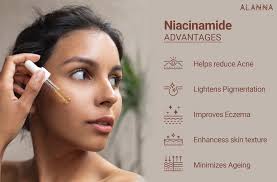
What Is Niacinamide? A Simple Guide to This Superstar Skincare Ingredient
In the fast-paced world of skincare, it can feel like there’s always a new ingredient trending.From acids to antioxidants, every product seems to boast the latest miracle solution.
One ingredient that’s stood the test of time is niacinamide, also known as vitamin B3. It’s been used by dermatologists for decades and is now a trusted favorite in many modern skincare lines.
If you’re unsure what niacinamide does or how it helps your skin, you’re not alone. Let’s break it down together in plain, easy-to-understand language.
What Is Niacinamide?
Niacinamide is a form of vitamin B3 that’s used in many skincare products. It supports the skin’s natural barrier and helps treat various concerns like acne, redness, and signs of aging.
Unlike some vitamins, your body can’t make niacinamide on its own. This means you need to get it from food, supplements, or skincare products.
When applied topically, niacinamide works directly on the skin to improve texture, tone, and hydration. It’s water-soluble, which means it blends well into most formulas like serums, moisturizers, and toners.
Top Benefits of Niacinamide for Skin
Niacinamide is called a “multi-tasker” for a reason—it offers a long list of benefits.
Here’s what it can do for your skin:
1. Boosts Skin Hydration
Niacinamide strengthens the skin barrier and helps it hold on to water. This leads to more hydrated, plumper, and softer skin.It also helps skin make more natural hyaluronic acid, which keeps moisture locked in.
2. Fights Fine Lines and Wrinkles
By supporting collagen production, niacinamide helps reduce fine lines and signs of aging. Your skin will look firmer and smoother with regular use.
3. Evens Out Skin Tone
Niacinamide helps reduce hyperpigmentation and fade dark spots and acne scars. It blocks the transfer of pigment within the skin, which makes skin tone look more even over time.
4. Reduces Redness and Inflammation
This ingredient calms the skin and reduces visible redness and irritation. That’s why it’s helpful for skin conditions like rosacea and sensitivity.
5. Helps Manage Acne
Niacinamide regulates oil production and reduces breakouts. It also minimizes inflammation and can speed up healing of blemishes.
6. Shrinks Pores
It won’t physically “close” pores, but it can reduce the appearance of enlarged ones. Healthier, balanced skin leads to a smoother, more refined look.
7. Protects Against Environmental Damage
Niacinamide works as an antioxidant, shielding your skin from pollution and harmful free radicals. It strengthens your skin barrier, which helps it defend against daily stressors.
Is Niacinamide Good for All Skin Types?
Yes—niacinamide is one of the most universally tolerated ingredients in skincare.
It works well for:
Oily skin: Helps control sebum and prevent clogged pores. Dry skin: Improves hydration and repairs the barrier. Combination skin: Balances oil in some areas while soothing dryness in others.
Sensitive skin: Reduces redness and helps calm irritation. Mature skin: Smooths wrinkles and supports collagen levels. It’s gentle enough for daily use and won’t cause dryness or peeling like other actives might.
How to Choose the Right Niacinamide Product
Niacinamide is found in many different types of products—choose the one that fits your routine.
If You Have Oily or Acne-Prone Skin:
Try a lightweight serum or gel with niacinamide as the key active. Look for additional ingredients like zinc, salicylic acid, or tea tree oil for extra acne-fighting power.
If You Have Dry Skin:
A cream or moisturizer with niacinamide helps seal in hydration. Pair it with ceramides, glycerin, or shea butter for deeper moisture.
If You Have Sensitive Skin:
Go for a fragrance-free, alcohol-free niacinamide product to avoid irritation. Choose calming formulas with aloe vera, centella asiatica, or oat extract.
How and When to Use Niacinamide
You can use niacinamide both morning and evening. It absorbs quickly and doesn’t interfere with other products. Apply it after cleansing and toning, but before thicker creams or oils.
Use 1-2 drops of serum or a dime-sized amount of cream on your face and neck. Because it’s non-irritating, you don’t need to “build up tolerance” like with retinol.
You can use it every day from the start—once or twice daily is ideal for most people. Can I Combine Niacinamide with Other Ingredients? Yes! Niacinamide pairs well with most skincare actives.
Here are some winning combos:
With hyaluronic acid: Boosts hydration and plumps skin. With retinol: Soothes irritation and strengthens the skin barrier. With AHAs or BHAs: Reduces dryness or redness from exfoliants.
With vitamin C: Brightens skin and evens out tone (best in low pH formulas). In the past, people worried about using niacinamide and vitamin C together.
But newer studies show they work just fine together in well-formulated products. How Long Until You See Results? You might notice skin feeling softer and more hydrated within a few days.
Visible improvements—like fewer spots, smaller pores, or more even tone—take more time. Most users report seeing noticeable changes within 8 to 12 weeks with consistent use.
Look for products with at least 5% niacinamide for maximum effectiveness. Stronger concentrations (up to 10%) are available, but start with a lower dose if you have sensitive skin.
Are There Side Effects to Niacinamide?
Most people tolerate niacinamide very well. That said, some may experience:
Mild redness
Itching or tingling
Warmth or a slight burning feeling
These are rare and usually go away quickly. If the irritation lasts more than a few days, stop using the product and consult a doctor.
Niacinamide is generally considered safe during pregnancy and breastfeeding, but always check with your healthcare provider.
Niacinamide vs Other Skincare Ingredients
Still wondering how it compares to other popular skincare actives? Here’s a quick breakdown:
Ingredient Benefits Works Well With Niacinamide?
Yes
Yes
Yes (in proper formula)
Yes
Yes
Benzoyl Peroxide Acne treatment, kills bacteria ⚠ Use with caution
Niacinamide enhances the effectiveness of many other ingredients without causing irritation. This makes it an ideal choice for layering in a more complex routine.
Final Thoughts: Why Niacinamide Deserves a Spot in Your Routine
Niacinamide is a gentle, affordable, and science-backed skincare superstar. Its long list of benefits—hydration, anti-aging, calming, brightening—makes it suitable for almost everyone.
Whether you’re battling acne, dryness, or dullness, niacinamide can help. It’s a great entry-level active for beginners, but powerful enough for experienced skincare lovers too.
You can easily add it into your routine without needing to stop other products.
Quick Tips Recap
Use niacinamide 1–2 times daily after cleansing. Start with 2–5% concentration for beginners. Mix well with almost all skincare ingredients.Store in a cool, dry place and use consistently.
Expect results in 8–12 weeks of regular use.


